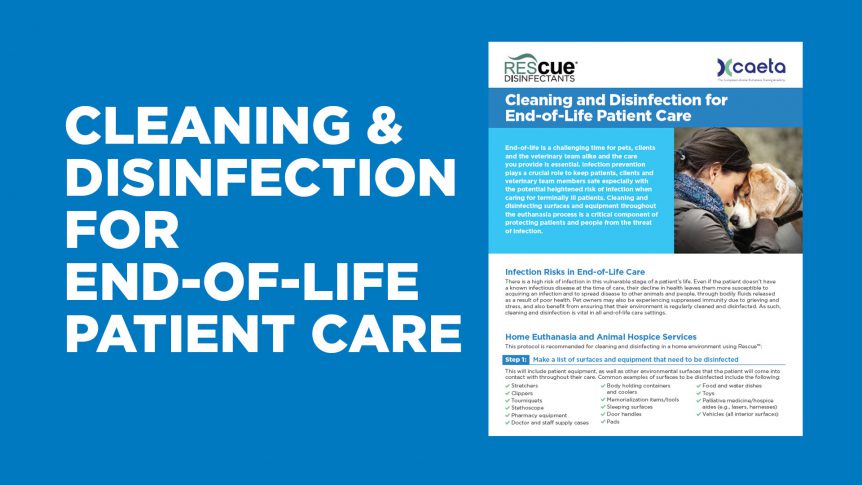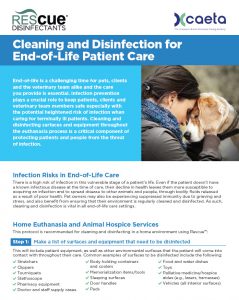End-of-life is a challenging time for pets, clients and the veterinary team alike and the care you provide is essential. Infection prevention plays a crucial role to keep patients, clients and veterinary team members safe especially with the potential heightened risk of infection when caring for terminally ill patients. Cleaning and disinfecting surfaces and equipment throughout the euthanasia process is a critical component of protecting patients and people from the threat of infection.
Infection Risks in End-of-Life Care
There is a high risk of infection in this vulnerable stage of a patient’s life. Even if the patient doesn’t have a known infectious disease at the time of care, their decline in health leaves them more susceptible to acquiring an infection and to spread disease to other animals and people, through bodily fluids released as a result of poor health. Pet owners may also be experiencing suppressed immunity due to grieving and stress, and also benefit from ensuring that their environment is regularly cleaned and disinfected. As such, cleaning and disinfection is vital in all end-of-life care settings.
Home Euthanasia and Animal Hospice Services
This protocol is recommended for cleaning and disinfecting in a home environment using Rescue™:
Step 1: Make a list of surfaces and equipment that need to be disinfected
This will include patient equipment, as well as other environmental surfaces that the patient will come into contact with throughout their care. Common examples of surfaces to be disinfected include the following:
- Stretchers
- Clippers
- Tourniquets
- Stethoscope
- Pharmacy equipment
- Doctor and staff supply cases
- Body holding containers
- and coolers
- Memorialization items/tools
- Sleeping surfaces
- Door handles
- Pads
- Food and water dishes
- Toys
- Palliative medicine/hospice
- aides (e.g., lasers, harnesses)
- Vehicles (all interior surfaces)
Step 2: Determine how frequently each surface will need to be cleaned and disinfected
- As a general rule, patient contact surfaces and equipment should be disinfected after each patient, whereas other lower-risk surfaces may need to be disinfected only daily or less frequently.
Step 3: Choose your disinfectant product based on your needs
- Rescue Wipes are ideal for taking on the go in mobile services, and for wiping high-touch surfaces and equipment between patients in a home care or professional setting.
- If you’re working with larger surfaces such as stretchers and gurneys, Rescue bucket wipes, which are larger in size compared to canister wipes, allow you to cover a greater surface area with a single wipe.
Step 4: Pre-clean heavily soiled areas
Get the surface ready for disinfection by wiping any visible soils from surfaces and equipment. This may
include bodily fluids, or any other debris that may be present.
Step 5: Use Rescue Wipes making sure the entire surface is visibly wet
- Rescue Wipes are non-irritating to eyes and non-corrosive to skin, the use of gloves are recommended when disinfecting to protect against cross-contamination.
- Wipes kill viruses, bacteria and fungi in one minute*, so it is important to allow surfaces to stay wet, undisturbed, to let the disinfectant work properly.
As the only Fear Free™ disinfectant, Rescue is proven to remove fear pheromones from surfaces, which may help reduce fear, stress and anxiety. To learn more about Fear Free™, visit https://fearfreepets.com
Step 6: Let surfaces air dry, or wipe dry if desired
- Rescue Wipes doesn’t leave any active chemical residues or harsh odors behind. After the surface is disinfected, it can simply be allowed to air dry or wiped dry with a clean damp cloth.
Within professional settings such as crematories, the protocols detailed above are also recommended. However, depending on the surfaces you need to disinfect, you may consider other Rescue products in addition to Wipes, such as Ready-to-Use liquid and Concentrate.
To learn more about Rescue product offerings and other resources available, visit www.LearnAboutRescue.com.


